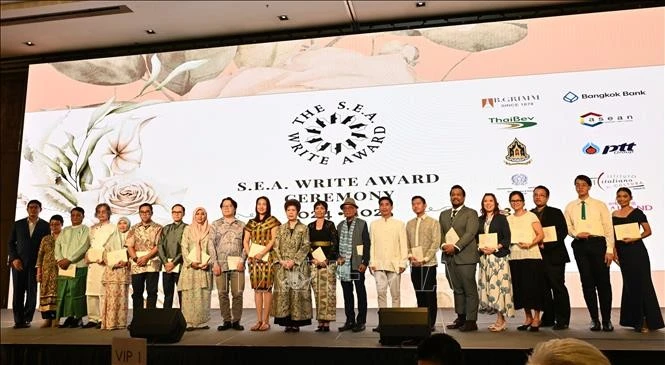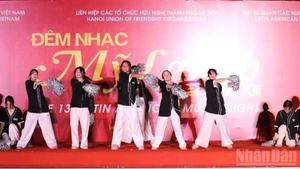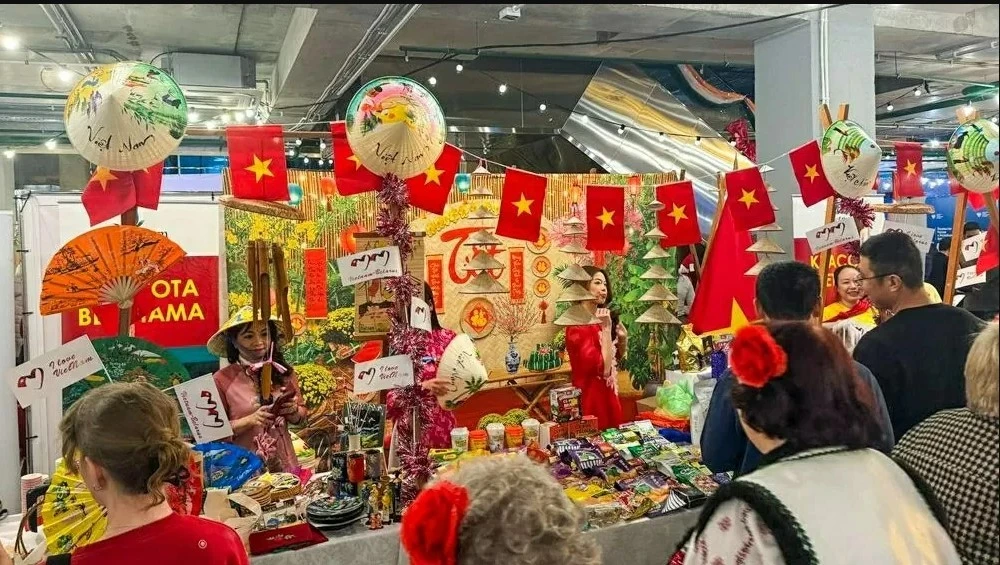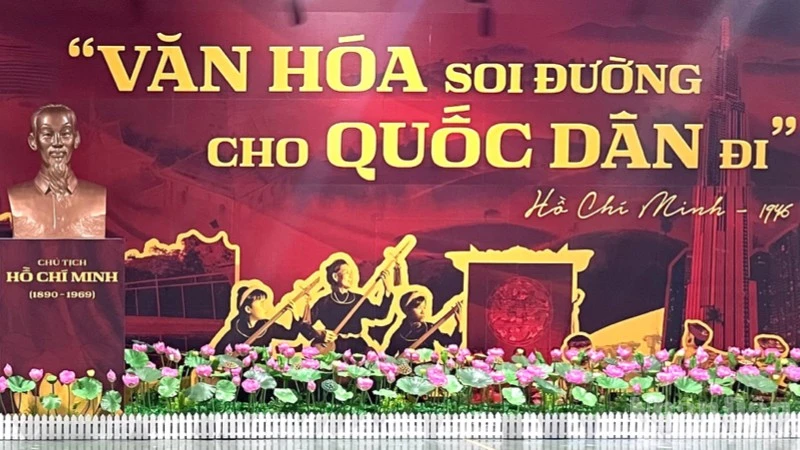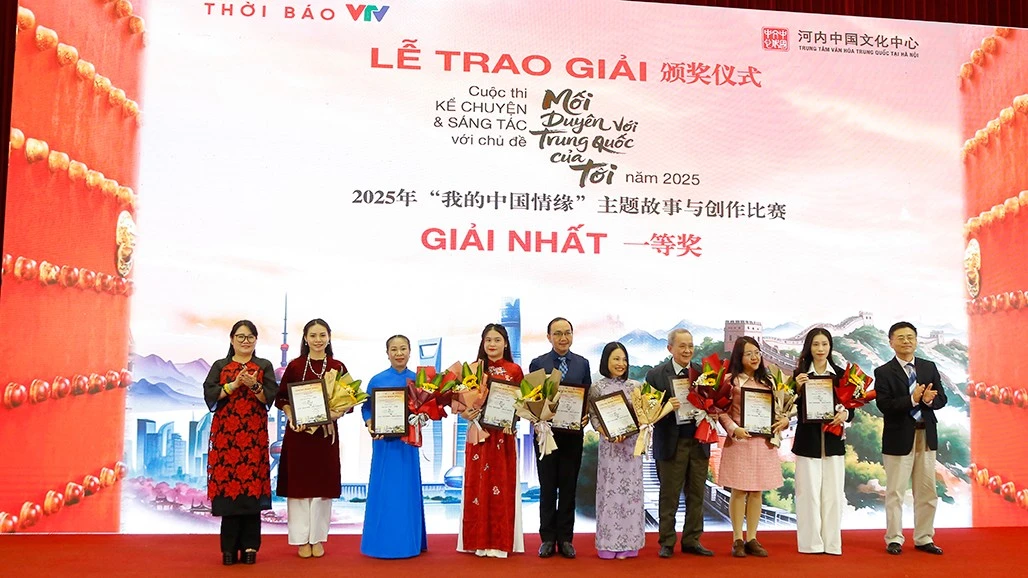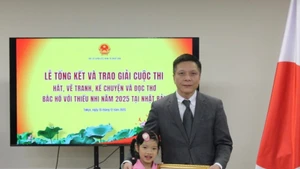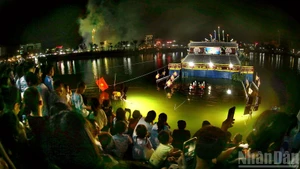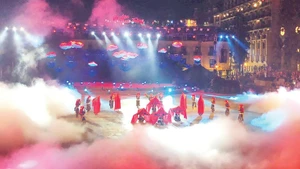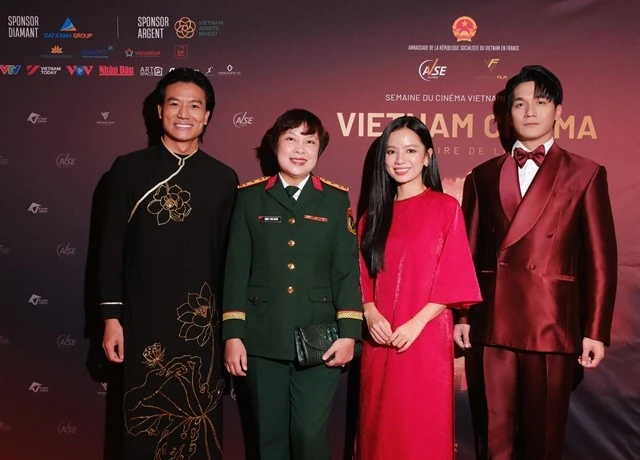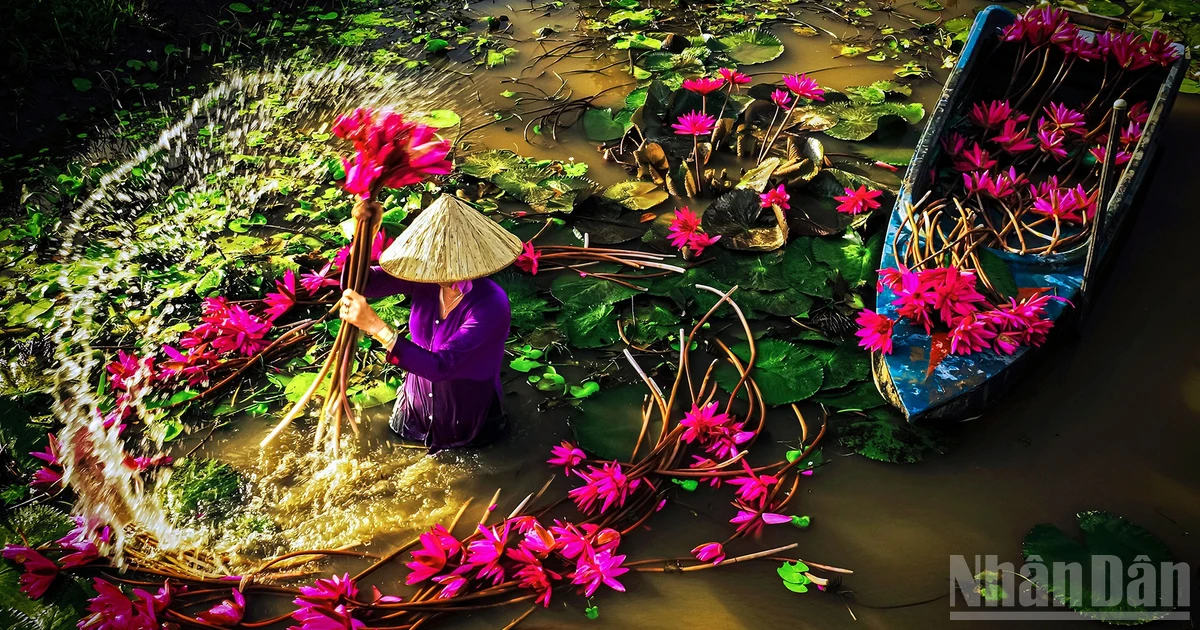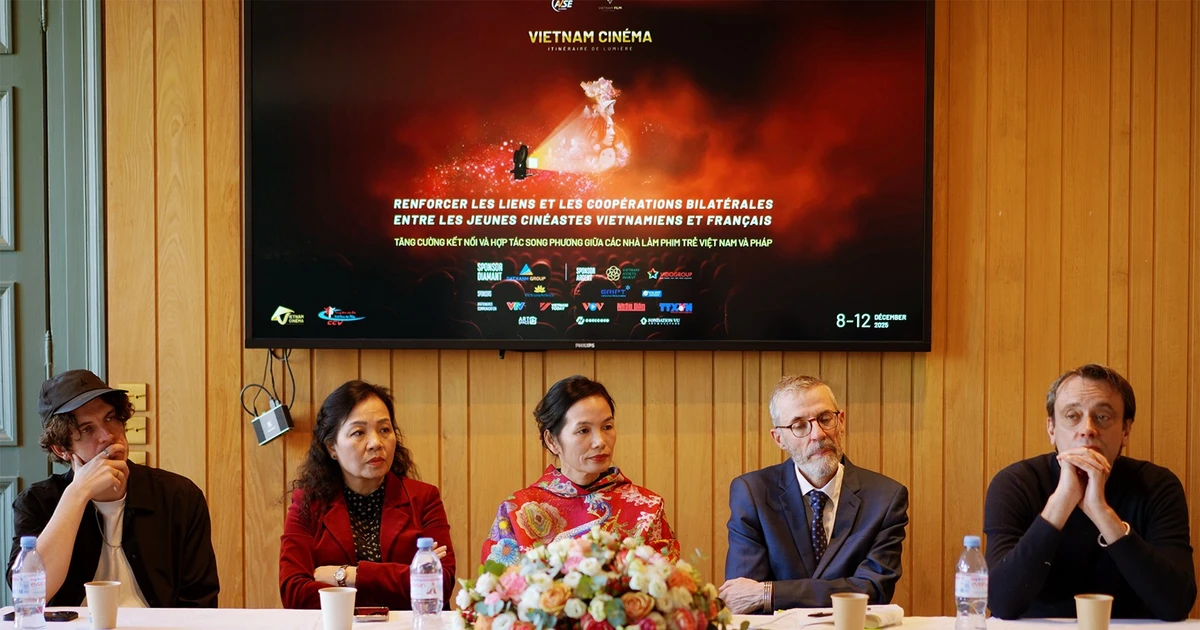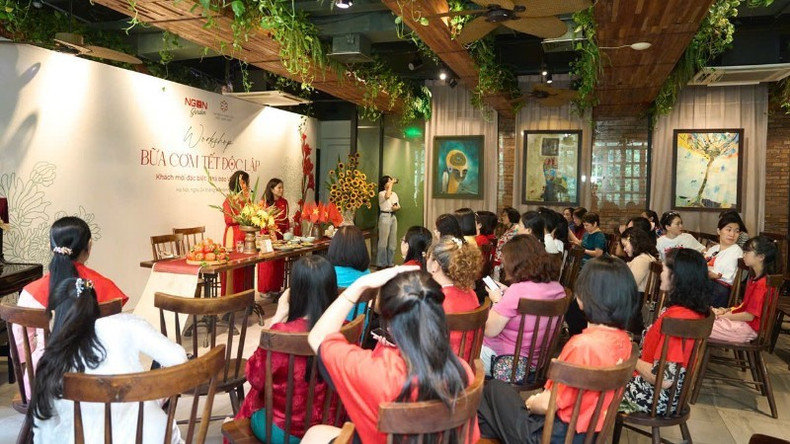
From the days of August 1945
Phu Gia is an ancient village, established in the late Le and early Nguyen dynasties. After many changes in administrative boundaries, Phu Gia belonged to Phu Thuong Commune, now Phu Thuong Ward, Ha Noi. Situated by the Red River, the village was destined to take part in a special historic event of the nation.
In the last days of August 1945, the Red River’s waters also swelled, surging with silt, flooding the mulberry fields along the riverbanks. A boat drifted downstream, quietly docking at a sandy bank leading into Phu Gia Village as dusk fell.
A group of people quietly left the boat and discreetly entered the village. They stopped in front of a house, pushed open its low wooden gate, stepped across a wide square-brick courtyard, and entered a five-room brick house with four words engraved above the porch: “Clear Moon, Cool Breeze.”
This was the home of Cong Ngoc Lam and Nguyen Thi An. Later, their daughter, Cong Thi Thu, then 17 years old, recalled: “On August 23, 1945, comrade Hoang Tung, Chairman of the Revolutionary People’s Committee, came to inform us that the family should prepare to welcome a group of cadres returning from the resistance base to Ha Noi.”
At that time, although the August Revolution had broken out, in Phu Thuong, enemy posts manned by local collaborators of the French colonialists and Japanese fascists still guarded the main roads leading to Ha Noi, so maintaining secrecy for the “senior cadres from the base” was paramount.
Upon receiving the notice, the Lam family hurriedly cleaned the house. Around 6 p.m., comrade Hoang Tung led the group of senior cadres to the house — 12 people in all — dressed in mountain attire and carrying weapons.
Among them was an elderly man with a long beard, bright eyes, a thin figure, but brisk movements. Though wearing highland clothes, he spoke in a gentle, warm central accent. As dinner had already been prepared, comrade Hoang Tung only asked An and her daughter to cook a pot of porridge for the group to eat after their late-night work.
An told her daughter to slaughter a chicken for porridge. When it was cooked, they brought it up to the group. The elderly man and the cadres accepted it without hesitation and ate heartily. The elderly man praised the porridge and thanked the family for their warm reception.
Thu continued: “The next day, my mother thought he needed nourishment, so she cooked different dishes to vary the taste. Knowing he liked vegetables, my mother and I made simple soups from the delta, such as taro soup, banana soup, and bean soup.”
It seemed the dishes suited his taste, and he and the cadres ate heartily. Thu recalled he worked continuously — typing, meeting, sleeping little — yet his health seemed to improve.
The group stayed and worked at An’s house from August 23 to 25, 1945. On the afternoon of August 25, 1945, two black cars brought more cadres, who met with the elderly man at the wooden table set. They were Truong Chinh, Nguyen Luong Bang, Vo Nguyen Giap, and Tran Dang Ninh.
When the meeting ended around 5 p.m., the elderly man called An over and said they must urgently move into the inner city to work, while sending thanks and farewells to the family. He promised to return when conditions allowed.
On September 2, crowds of Hanoians poured into Ba Dinh Square for the rally where President Ho Chi Minh read the Declaration of Independence, founding the Democratic Republic of Viet Nam. Early that morning, Thu, as part of the Youth for National Salvation, joined the delegation of officials and residents from her commune to attend.
When the leaders appeared on stage, she was astonished to see the elderly man from her house standing near the microphone, now wearing light-coloured clothes. When he began to speak and read the Declaration, she knew for certain it was the same man — and it was President Ho Chi Minh.
After the rally, she ran home to tell her parents the joyful news. The whole family was overjoyed, moved to tears, never having imagined that their home had hosted President Ho Chi Minh and served him meals in those crucial days before Independence.
From then on, every Independence Day, Thu’s family, the people of Phu Gia village, and families across Viet Nam prepared a feast to celebrate.
To the Independence Day feast of 2025
Eighty years later, the Independence Day feast has become familiar to families in Ha Noi and throughout Viet Nam. The meal not only marks the historic event of becoming citizens of an independent Viet Nam, but also commemorates President Ho Chi Minh, who passed away on September 2, 1969.
Vietnamese people have always valued food, so major holidays and important events are inseparable from meals. Around square or round trays symbolising earth and sky, people share both sweetness and hardship.
Independence Day’s meals are not valued merely for lavish feasts or delicacies, but for the moments of sincerely sharing mouthfuls of food and the chance to clasp hands, to exchange smiles with tearful eyes. National Day has become a new festival of the nation since 1945 — Independence Festival — and thus no feast table could ever be absent on this day.
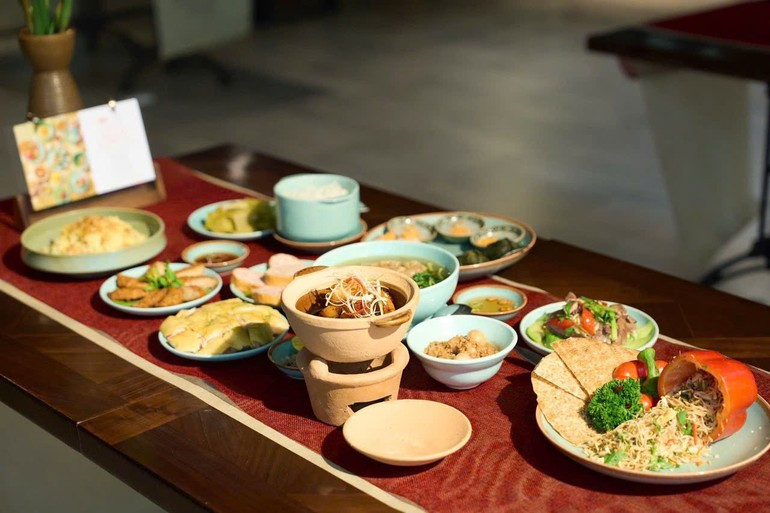
It is a meal to celebrate and to remind one another of the proud moment of being Vietnamese in an independent Viet Nam. Over eight decades, the Independence Festival feast has become a custom and tradition. Therefore, on National Day 2025, women in Ha Noi, in keeping with tradition, continued to prepare meaningful Independence Festival meals.
Such a feast cannot lack refinement, neatness, and meticulous preparation, but it must also embody the spirit of Vietnamese cuisine, especially dishes and localities linked to this historic founding event, such as Nghe An, Ha Noi, and Phu Thuong, along with the culinary quintessence representing the three regions of North–Central–South.
Sharing this sentiment, culinary-skilled women of Ha Noi such as journalist Vinh Quyen and entrepreneur Pham Thi Bich Hanh — owner of Ngon Garden restaurant, listed three times in the Michelin Selected category — prepared an Independence Day feast to welcome distinguished guests to the capital this year.
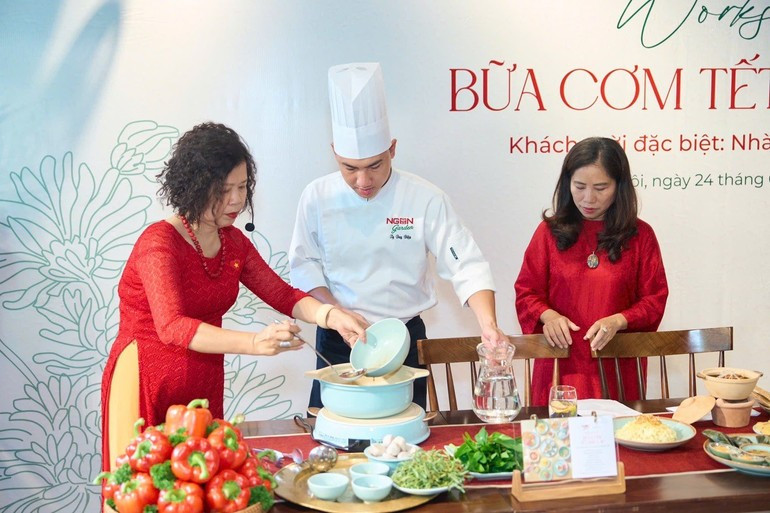
The Independence Day feast consists of 10 dishes: Thanh Chuong jackfruit salad, loofah stir-fried with chicken giblets, chicken steamed with lime leaves, Ha Noi green rice patties, Phu Thuong corn sticky rice, Hue sticky rice cake (banh it), Nam Dan eggplant pickled in soya paste, braised Pangasius krempfi in a clay pot, crab soup with taro, water mimosa and duckweed, and a dessert of lotus seed and longan sweet soup served in coconut.
Just by looking at the feast, diners could see its purpose: honouring National Day (September 2), the figures and places tied to the event, and symbolising national unity with dishes from North, Central, and South, all gathered around one tray from appetiser to dessert.
From Nghe An, homeland of “the senior cadre” — President Ho Chi Minh — came Thanh Chuong jackfruit salad and Nam Dan pickled eggplant. The jackfruit salad mentioned in the Nghe An proverb “Thanh Chuong jackfruit, Nam Dan soya paste” was a familiar dish for the people of Nghe An, especially during the lean crop season. Young jackfruit, thinly sliced and salted to be eaten with rice, has now become the Thanh Chuong speciality. On this Independence Day meal tray, Thanh Chuong jackfruit salad has been transformed into a refined and delightful jackfruit salad, creating a memorable dish.
The bowl of Nam Dan pickled eggplants pairs harmoniously with a bowl of crab soup with water spinach, water mimosa and taro, the very dish that An cooked 80 years ago to serve the “senior comrade” – President Ho Chi Minh. Crab soup with pickled eggplants eaten with plain rice has long been a culinary symbol of the Red River Delta and the North Central region. Complementing these is braised Pangasius krempfi in a clay pot, representing the cuisine of the Mekong Delta.
A hallmark of the land that welcomed the senior cadre delegation back to the capital to prepare for National Day on September 2, 1945 is the Phu Thuong corn sticky rice. The village, home to Lam and An, has long been renowned for its traditional craft of making sticky rice—soft, fragrant, plump and glossy.
The fame of Phu Thuong sticky rice has spread far and wide throughout the country, and in February 2024, the craft of Phu Thuong sticky rice was inscribed on the list of National Intangible Cultural Heritage. Today, in the very village where President Ho once set foot, more than 600 households continue to practise the traditional sticky rice steaming craft.
In addition to Phu Thuong sticky rice, carrying a distinct geographical hallmark, the meal tray also includes the unique, time-honoured Ha Noi green rice cake (cha com), embodying the very spirit of Ha Noi’s culinary tradition. For though green rice grains are found elsewhere, it is only the people of Ha Noi who imparted the heart and refinement to transform them into such a noble and delicate dish.
Thus, cha com deserves to represent Ha Noi’s cuisine in the Independence Day meal tray. The cha com has a crispy outer layer, with the soft sticky green rice grains blended with finely ground pork inside. The dish combines the sweetness of meat, the richness of fat, and the chewy, nutty flavour of fresh green rice.
Ha Noi cha com is both chewy and nutty. The chewiness symbolises solidarity, while the nutty sweetness recalls the saying “remembering bitter times in sweetness”, evoking the hardships endured before national independence. Moreover, the finest season for green rice in Ha Noi is autumn, when the paddy just ripens, releasing the fragrance of young rice into the winds of the Independence autumn.
And so, each dish in the Independence Day meal tray carries subtle layers of meaning. The braised Pangasius krempfi embodies the flavours of the southern waterways; the Hue-style banh it with shrimp and pork filling is both elegant and elaborate; while the banh la reflects the rustic character of the central region.
The Independence Day meal tray concludes with a coconut sweet soup dessert, a southern fruit cooked with Hung Yen longans, Tinh Tam lotus seeds (Hue), and Duc Pho rock sugar (Quang Ngai), prepared in the style of Ha Noi’s sweet soups. This dessert is at once beautiful, delicious, light and sweet, embodying the spirit of “joining hands in unity”.
Some meanings are explicit, others subtle, but all those who partake of the Independence Day meal tray can sense and appreciate them. For ultimately, it is the shared meaning of compatriots gathering around the meal tray to celebrate Independence Day and the 80th National Day of the Socialist Republic of Viet Nam.

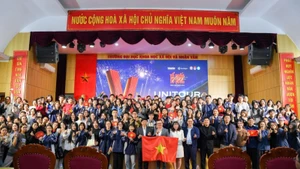
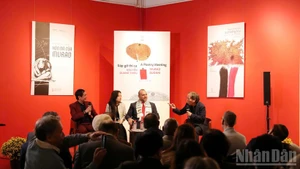
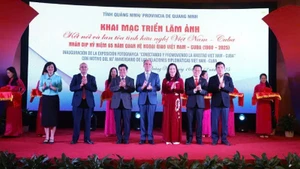
![[In Pictures] Award ceremony of the Human Act Prize 2025](https://en-cdn.nhandan.vn/images/5992a12dd6e78b9bfb434962ff18307331f51c4c3a3e5fcfcd42f0234766d9c42f03518febde2c9d258f98c1db4a3b214eb54d6f36cee30ec8ae9b858fada279/171225-da-10.jpg.webp)
